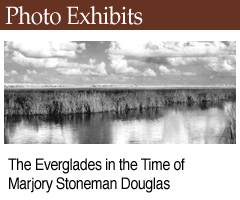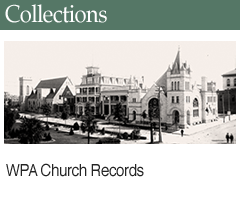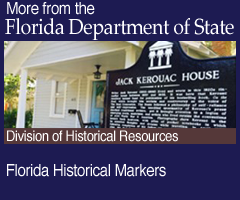Guide to the Koreshan Unity Papers
at the State Archives of Florida
The collection documents the economic and cultural development of southwest Florida; the relationship between religion and community; the Koreshans' methods of integrating concepts of science into their religious cosmology and cosmogony; the Koreshans' sometimes tumultuous relations with surrounding communities; and major leadership roles of women in a community whose belief system included equality of the sexes. The collection also provides valuable documentation of the overall history and development of millennial communities and communal utopias in the United States in the middle- to late-19th century into the early 20th century.
The collection includes correspondence among Koreshans and between them, outside relatives, and others. In addition to papers of Koreshan Unity founder Cyrus Teed ("Koresh"), the collection includes papers of key early members who formed the nucleus of Koreshan organization, community, and culture; member writings and tracts on cosmogony, cellular cosmogony, science, religion, philosophy, horticulture, and other topics reflecting the beliefs and ideas of the community and their imethods of integrating concepts of science into their religious cosmology and cosmogony; histories of member families and the organization; and administrative and operational records of the organization, from early constitutions and other foundation documents to minutes, correspondence, and business and financial records.
Photographic prints and glass plate negatives in the collection document the early development of Koreshan life and beliefs and the lives and activities of Koreshan members; of particular note are photographic images of Cyrus Teed's body after his death as his followers awaited his resurrection. Organizational and administrative records provide evidence of the organization, growth, and development of the Koreshan Unity as a religious, scientific, business, and social community. A great deal of material relates to the Koreshans' cultural life, including personal correspondence about daily life, recipes, scripts for shows written and performed by members, and both original and commercial sheet music dating back to 1898.
The collection is organized into nine series as described and listed below.
Series 1: Photographic Files, ca. 1887-1990, 10 cubic ft.
Boxes 1-22
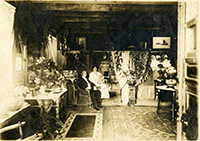
The photographic files contain thousands of photographs in the following formats: prints, postcards, 35MM negatives, glass plate negatives, lantern slides, and 35MM slides. The Koreshans developed an extensive and rich collection of photographs documenting the early development of Koreshan life and beliefs and the lives and activities of Koreshan members spanning the life of the organization.
In addition to portraits of Cyrus Teed and his family prior to the Koreshan years, images in the collection depict Koreshan members and headquarters in Chicago; development of the Koreshan Unity settlement in Estero, including gardens, the Bamboo Landing, residence buildings, the Art Hall, the Dining Hall, and other facilities; Koreshan activities such as plays, concerts, and festivals; and notable visitors including Thomas Edison and Henry Ford. Of particular note are images of Cyrus Teed and other early founder and leaders; Koreshans with the Rectilineator used to demonstrate the concave nature of the earth's surface; Teed's body after his death as his followers awaited his resurrection; and the aftermath of the hurricanes of 1921 and 1926.
Series 2: Administrative Files, ca. 1887-2006, 51.13 cubic ft.
Boxes 23-114
The Administrative Files series is comprised of 10 subseries: Foundational Documents, Membership Records, Correspondence Files, Financial Records, Legal Records, Pioneer Education Foundation Records, Properties and Land Records, Koreshan Store Records, Trailer Park Division Records, and Subject Files.
Series 3: Hedwig Michel Files, ca. 1920-1982, 5.83 cubic ft.
Boxes 115-147
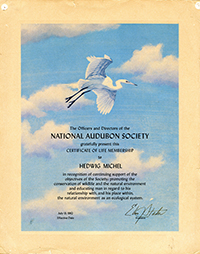
The Hedwig Michel Files Series is comprised of 4 subseries: Correspondence, Financial, Legal, and Subject Files. Although the majority of the Koreshan Unity Papers' original order has been lost, much of Michel's files have retained their filing scheme. This series of boxes was contained and separated from all other portions of the collection, possibly a result of its more recent creation in Estero. While the vast majority of this series is in English, there are portions in German and French. When this is the case, it is noted in the folder listings. All subseries are described below.
Series 4: Member Files, ca. 1874-1985, 28.96 cubic ft.
Boxes 148-241
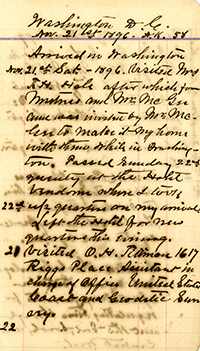
The Member Files are arranged alphabetically by last name. When the creator or accumulator of the records was not discernible, the files were placed under “Unidentified” and were then arranged by record type. Evidence of earlier processing efforts is clear within a portion of the member correspondence where letters had been indexed, transcribed, and placed within binders separated by the member that collected them. This arrangement has been preserved and has been described as “bindered correspondence” at the box level.
Daily life is captured within the correspondence, manuscripts, and the various other personal papers of Koreshan members. At the Unity's height, it is estimated that there were upwards of 200 members in Estero. Many individuals and families shaped the history of the Koreshan Unity, but only a portion of their records remain within the Koreshan Unity Papers. In the Andrews, Bubbett, Silverfriend, and Rahn member files, researchers will find a wide range of materials that detail the Koreshan way of life. Of note are the diaries and journals of Virginia Andrews and Claude Rahn. Both will give readers a more personal sense of the Unity.
Series 5: Publications, 1877-1993, 42.04 cubic ft.
Boxes 242-318
The Publications series contains three subseries: Koreshan Literature, Koreshan Periodicals, and General Publications.
Series 6: Events Files, ca. 1888-1989, 8.5 cubic ft.
Boxes 319-329
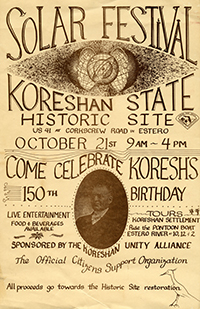
This series consists of event-specific files and plays. The event-specific files are arranged alphabetically and include programs, readings, and souvenirs that correspond to the event. Of particular interest are the Solar and Lunar Festival files. The Solar Festival honored Cyrus Teed's birthday (October 18, 1839) and was held yearly in mid-October. The Lunar Festival was a mid-April gathering that commemorated the birth of Annie G. Ordway (Victoria Gratia). The Solar and Lunar Festivals were celebrated both in Chicago and Estero, and the files provide insight into the social aspects of the Unity from its early stages to the late 1980s.
The plays are arranged alphabetically by title. The files include a wide range of scripts, script edits, and musical accompaniment used by the Unity for entertainment throughout their history. Some of the plays were created by Koreshan members, while others are mainstream productions. The plays cover a myriad of subjects, ranging from historical reenactments of the Koreshan Unity to popular culture and politics.
Series 7: Scrapbooks, ca. 1900-1993, 13.89 cubic ft.
Boxes 330-371
This series consists of scrapbooks containing newspaper clippings and articles on both Unity and Ft. Myers events. The information contained in the scrapbooks is useful in tracing the history and local events of Southwest Florida. All scrapbooks are arranged individually by topic.
Series 8: Music, 1829-1970, 30.75 cubic ft.
Boxes 372-409
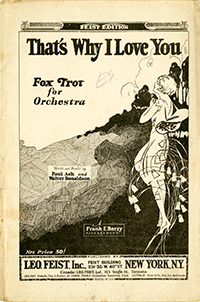
The Music series contains six subseries: Sheet Music (Boxes 372-388), Songbooks (Boxes 389-401), Books (Boxes 402-404 ), Music Journals (Boxes 405-406), Phonograph Records (Box 407), and Miscellaneous or unidentifiable items (Boxes 408-409). All are arranged alphabetically within each box. This series contains all commercial music collected by the Koreshan Unity for use by their band or orchestra, in public event performances, and as a general source of entertainment for Unity members.
Series 9: Audio Visual, 1959-1998, 2.25 cubic ft.
Boxes 410-415
The Audio Visual series contains reel to reels, cassette tapes, and video tapes. All are grouped by format and then arranged individually by the title given at the time of creation. The largest portion of the series documents board and membership meetings from the 1970s through the 1990s. The tapes also contain interviews from Hedwig Michel and others who helped with Unity efforts in later years. Unity and Nature Conservancy events are captured in this series. When information was not found on the item, it was marked unidentified.

 Listen: The Assorted Selections Program
Listen: The Assorted Selections Program